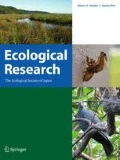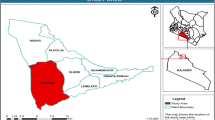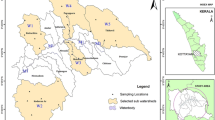Abstract
Optimal sampling area for biodiversity monitoring is a classical scientific topic for the biodiversity research in view of the cost, human resources and ecological significance. However, how much sampling area is enough for biodiversity monitoring in riparian area, the ecotone among freshwater and terrestrial system? Whether the optimal sampling areas are different among ecoregions? To explore these scientific questions, the minimum sampling area of riparian herbs was studied in Taizi river, Liaoning province, China. The species-area relationship was modeled using average species richness in the same area (2.25, 4.5, 6.75 and 9 m2) of 55 sites distributed along riparian zone of Taizi river water course. The power model S = aA b modeled best, and was selected to fit species-area curves. The minimum sampling areas for total species and dominant families were calculated via the selected model and corresponding estimated species richness. Results showed that the minimum sampling areas (MSAs) for herbs diversity monitoring in whole basin, highland ecoregion, midland ecoregion and lowland ecoregion of Taizi river were 12.82, 12.06, 13.46 and 13.08 m2,respectively. The MSAs of dominant families Compositae species and Graminale species were similar to that of total species. The minimum sampling area of Taizi river riparian zone was similar to other temperate riparian grassland and wet grassland, larger than dry grassland and salt meadow. So we did not need consider ecoregion difference for temperate riparian herbs diversity monitoring in watershed scale.




Similar content being viewed by others
References
Allison JS, Smith RIL (1973) The vegetation of Elephant Island, South Shetland Islands. Brit Antarct Surv Bull 33–34:185–212
Arrhenius O (1921) Species and area. J Ecol 9:95–99
Bailey RG (1983) Delineation of ecosystem regions. Environ Manag 7:365–373
Balvanera P, Pfisterer AB, Buchmann N, He JS, Nakashizuka T, Raffaelli D, Schmid B (2006) Quantifying the evidence for biodiversity effects on ecosystem functioning and services. Ecol Lett 9:1146–1156
Barkman JJ (1989) A critical evaluation of minimum area concepts. Vegetatio 85:89–104
Barrat-Segretain MH (1996) Strategies of reproduction, dispersion, and copetition in river plants: a review. Vegetatio 123:13–37
Bendix J (1997) Flood disturbance and the distribution of riparian species diversity. Geogr Rev 87:468–483
Brashares JS, Sam MK (2005) How much is enough? Estimating the minimum sampling required for effective monitoring of African reserves. Biodivers Conserv 14:2709–2722
Bruner WE (1931) The vegetation of Oklahoma. Ecol Monogr 1:99–188
Cain SA (1938) The species-area curve. Am Midl Nat 19:573–581
Can-Ran L, Ke-Ping M, Shun-Li Y, Wei W (1998) Plant community diversity in Dongling Mountain, Beijing, China—the determination of critical sampling areas for several types of plant communities. Acta Ecol Sin 18:15–23 (in Chinese)
Chown SL, Gremmen NJM, Gaston KJ (1998) Ecological biogeography of Southern Ocean islands: species-area relationships, human impacts, and conservation. Am Nat 152:562–575
Connor EF, McCoy ED (1979) The statistics and biology of the species–area relationship. Am Nat 113:791–833
Critchley CNR, Poulton S (1998) A method to optimize precision and scale in grassland monitoring. J Veg Sci 9:837–846
Day RT, Keddy PA, McNeill J, Carleton T (1988) Fertility and disturbance gradients: a summary model for riverine marsh vegetation. Ecology 69:1044–1054
de Caprariis P, Lindemann RH, Collins CM (1976) A method for determining optimum sample size in species diversity studies. Math Geol 8:575–581
Denslow JS (1995) Disturbance and diversity in tropical rain forests: the density effect. Ecol Appl 5:962–968
Dietvorst P, van der Maarel E, van der Putten H (1982) A new approach to the minimal area of a plant community. Vegetatio 50:77–91
Drees EM (1954) The minimum area in tropical rain forest with special reference to some types in Bangka (Indonesia). Vegetatio 5:517–523
Ferreira LV, Stohlgren TJ (1999) Effects of river level fluctuation on plant species richness, diversity, and distribution in a floodplain forest in Central Amazonia. Oecology 120:582–587
Gardner TA, Cote IM, Gill JA, Grant A, Watkinson AR (2003) Long-term region-wide declines in Caribbean corals. Science 301:958–960
Gleason HA (1922) On the relation between species and area. Ecology 3:95–99
Goodall DW (1952) Quantitative aspects of plant distribution. Biol Rev 27:194–245
Goodall DW (1961) Objective methods for the classification of vegetation. IV. Pattern and minimal area. Aust J Bot 9:162–196
Gould VV, Walker MD (1997) Landscape-scale patterns in plant species richness along an arctic river. Can J Bot 75:1748–1765
Gregory SV, Swanson FJ, McKee WA, Cummins KW (1991) An ecosystem perspective of riparian zones. BioScience 41:540–551
Grévilliot F, Krebs L, Muller S (1998) Comparative importance and interference of hydrological and soil nutrient gradients in floristic biodiversity in flood meadows. Biodivers Conserv 7:1495–1520
Hancock CN, Ladd PG, Froend RH (1996) Biodiversity and management of riparian vegetation in Western Australia. For Ecol Manag 85:239–250
He F, Legendre P (1996) On species–area relations. Am Nat 148:719–737
Hopkins B (1957) The concept of minimal area. J Ecol 45:441–449
Hughes FMR (1988) The ecology of African floodplain forests in semi-arid and arid zones: a review. J Biogeogr 15:127–140
Inouye RS (1998) Species-area curves and estimates of total species richness in an old-field chronosequence. Plant Ecol 137:31–40
Jalonen J, Vanha-Majamaa I, Tonteri T (1998) Optimal sample and plot size for inventory of field and ground layer vegetation in a mature Myrtillus-type boreal spruce forest. Ann Bot Fenn 35:191–196
Keating KA, Quinn JF (1998) Estimating species richness: the Michaelis–Menton model revisited. Oikos 81:411–416
Kenkel NC, Podani J (1991) Plot size and estimation efficiency in plant community studies. J Veg Sci 2:539–544
Kilburn PD (1966) Analysis of the species-area relation. Ecology 47:831–843
Kong WJ, Meng W, Zhang Y, Gippel C, Qu XD (2013) A freshwater ecoregion delineation approach based on freshwater macroinvertebrate community features and spatial environmental data in Taizi river Basin, northeastern China. Ecol Res 28:812–819
Lévesque E (1996) Minimum area and cover-abundance scales as applied to polar desert. Arct Antarct Alp Res 28:156–162
Lite SJ, Bagstad KJ, Stromberg JC (2005) Riparian plant species richness along lateral and longitudinal gradients of water stress and flood disturbance, San Pedro River, Arizona, USA. J Arid Environ 63:785–813
Lughadha EN, Baillie J, Barthlott W, Brummitt NA, Cheek MR, Farjon A, Govaerts R, Hardwick KA, Hilton-Taylor C, Meagher TR, Moat J, Mutke J, Paton AJ, Pleasants LJ, Savolainen V, Schatz GE, Smith P, Turner I, Wyse-Jackson P, Crane PR (2005) Measuring the fate of plant diversity: towards a foundation for future monitoring and opportunities for urgent action. Philos Trans R Soc B Biol Sci 360:359–372
Mac Nally R, Bennett AF, Brown GW, Lumsden LF, Yen A, Hinkley S, Lillywhite P, Ward D (2002) How well do ecosystem-based planning units represent different components of biodiversity? Ecol Appl 12:900–912
Magnusson WE (2004) Ecoregion as a pragmatic tool. Conserv Biol 18:4–5
McNaughton SJ (1977) Diversity and stability of ecological communities: a comment on the role of empiricism in ecology. Am Nat 111:515–525
Moravec J (1973) The Determination of the Minimal Area of Phytocenoses. Folia Geobot et Phytotaxon 8:23–47
Mueller-Dombois D, Ellenberg H (1974) Aims and methods of vegetation ecology. Wiley, New York
Naiman RJ, Décamps H (1997) The ecology of interfaces: riparian zones. Annu Rev Ecol Syst 28:621–658
Naiman RJ, Decamps H, Pollock M (1993) The role of riparian corridors in maintaining regional biodiversity. Ecol Appl 3:209–212
Omernik JM (1995) Ecoregion: a framework for managing ecosystems. George Wright Soc Forum 12:35–50
Palmer MW (1990) The estimation of species richness by extrapolation. Ecol Soc Am 71:1195–1198
Pereira HM, Cooper HD (2006) Towards the global monitoring of biodiversity change. Trends Ecol Evol 21:123–129
Pimm SL (1984) The complexity and stability of ecosystems. Nature 307:321–326
Shuman CS, Ambrose RF (2003) A comparison of remote sensing and ground-based methods for monitoring wetland restoration success. Restor Ecol 11:325–333
Soberón M, Llorente JB (1993) The use of species-accumulation functions for the prediction of species richness. Conserv Biol 7:480–488
Stiles A, Scheiner SM (2007) Evaluation of species-area functions using Sonoran Desert plant data: not all species-area curves are power functions. Oikos 116:1930–1940
Tilman D, Wedin D, Knops J (1996) Productivity and sustainability influenced by biodiversity in grassland ecosystems. Nature 379:718–720
Tjørve E (2003) Shapes and functions of species-area curves: a review of possible models. J Biogeogr 30:827–835
Ward JV (1998) Riverine landscapes: biodiversity patterns, disturbance regimes, and aquatic conservation. Biol Conserv 83:269–278
Weaver TW, Klarich D (1977) Allelopathic effects of volatile substances from Artemisia tridentata Nutt. Am Midl Nat 97:508–512
Werger MJA (1972) Species-area relationship and plot size: with some examples from South African vegetation. Bothalia 10:583–594
Whittaker RH (1956) Vegetation of the great smoky mountains. Ecol Monogr 26:1–80
Whittaker RH, Niering WA (1965) Vegetation of the Santa Catalina Mountains, Arizona: a gradient analysis of the south slope. Ecol 46:429–452
Williams CB (1943) Area and number of species. Nature 152:264–267
Acknowledgments
This research is supported by the National Natural Science Foundation of China “Mechanism of habitat patches spatial heterogeneity during riparian natural rehabilitation process of riverine nature reserve” (Grant No. 41201187) and the “Major Science and Technology Program for Water Pollution Control and Treatment in China” (Grant No. 2012ZX07501001-02).
Author information
Authors and Affiliations
Corresponding author
About this article
Cite this article
Kong, W., Xia, H. & Zhang, Y. Minimum sampling area for the monitoring of herb diversity in riparian zone of temperate rivers, China. Ecol Res 31, 547–555 (2016). https://doi.org/10.1007/s11284-016-1363-x
Received:
Accepted:
Published:
Issue Date:
DOI: https://doi.org/10.1007/s11284-016-1363-x




